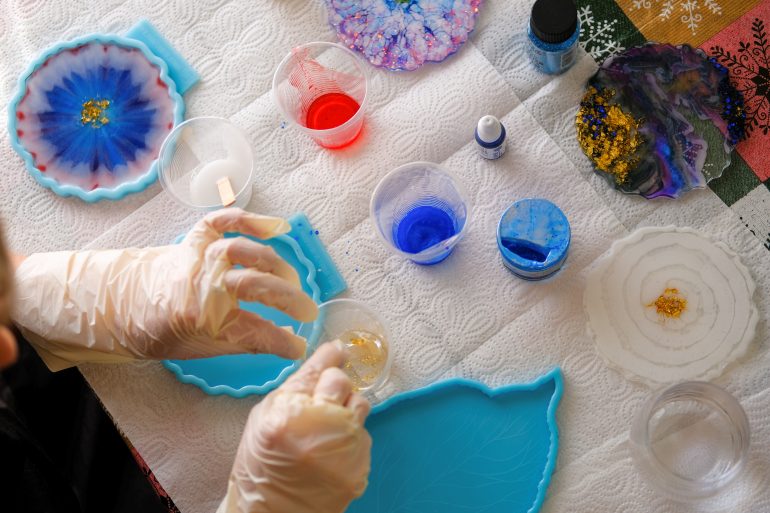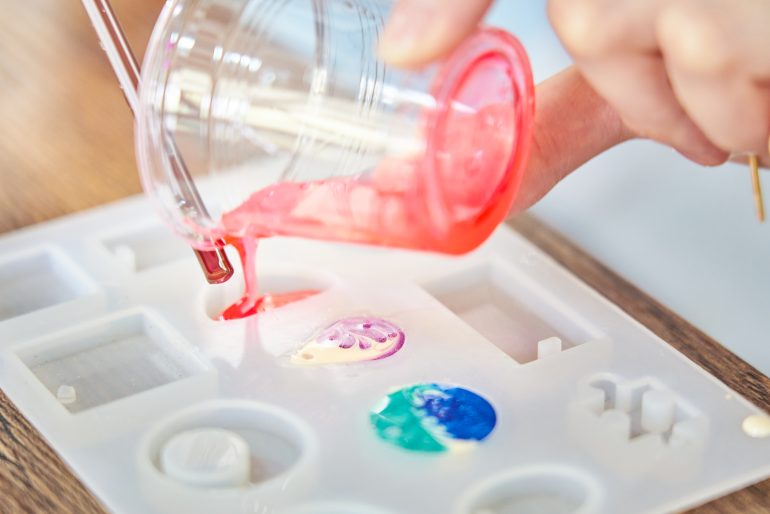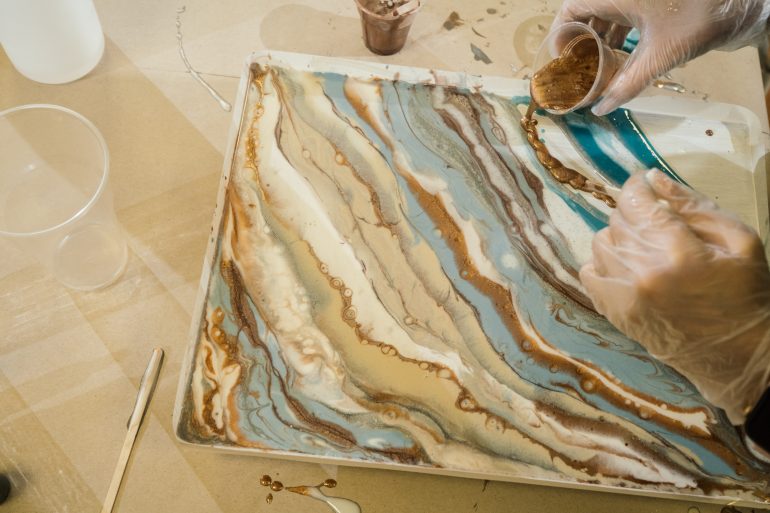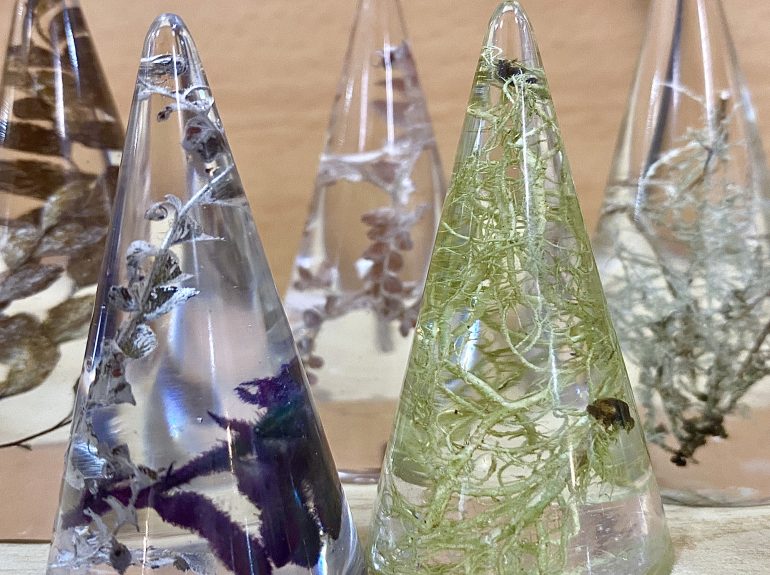This mesmerising form of artistry goes beyond the traditional boundaries of artistic mediums, converging chemistry with creativity, but what is resin art? At its core, it is the manipulation of epoxy resin — a viscous substance that hardens over time — to craft lustrous and often translucent designs.
Whether it’s shimmering jewellery pieces, enchanting paintings, or intricate sculptures, the versatility of resin art has helped it soar in popularity among contemporary artists and hobbyists alike. It’s not just the intriguing process that sets it apart, but also the final product, a radiant, glass-like finish that seems almost otherworldly.
In this article, we’ll answer the key questions about this delightful artform – what do you need for resin art, what paint can you mix with epoxy resin and above all, just what is epoxy resin art?
What is Epoxy Resin?

Making epoxy resin arts and crafts. Creation of handmade coaster. (Credit: Marina Cavusoglu via Getty Images)
Before we delve into the question of what is resin art, it’s useful to know what epoxy resin actually is.
Epoxy resin is a type of highly adhesive liquid material that, when mixed with a hardening agent, becomes solid and clear, similar to glass. The two-part compound is made up of the resin itself – which can be natural or synthetic – and a hardening agent. When the two are mixed, a chemical reaction occurs causing the mixture to gradually harden.
The solidified form is strong, durable, and has a glossy finish. Epoxy resin is often used in crafting, DIY projects as a coating for surfaces like tabletops, countertops, paintings and photographs and it is even used in some industrial applications.
It’s quite thick and will harden, depending on the thickness of the coating (usually between one and five millimetres) within hours or a day. It’s worth remembering that once epoxy resin and its hardener are mixed, they become hazardous waste and should be disposed of accordingly.
Casting Resin

Casting red resin into a resin mold. (Credit: Hydrogenn via Getty Images)
Casting resin is designed for casting objects in moulds. It’s ideal for making thick pieces like jewellery, paperweights, or larger objects. It’s thinner than epoxy resin to allow it to flow more freely and work its way into intricate nooks and crevices. Because it’s used in higher volume, the curing – hardening – time is much longer and can, depending on the thickness of the pour, take several days.
Both types of resin have their specific applications, and while there’s some overlap in their uses, it’s important to pick the right one. The product description and guidelines should always be followed.
It’s important to note that there are potential health concerns when working with epoxy resins, such as allergic reactions or respiratory issues. It’s important to follow all safety guidelines recommended by the manufacturer, which usually include working in well-ventilated areas with appropriate safety gear such as a respirator.
What is Resin Painting?

Liquid resin poured from a cup (Credit: Elena Nikonova via Getty Images)
When most people hear the word ‘painting’, thoughts immediately go to the Old Masters using oils on canvas, but resin painting moves the age-old art form into the twenty-first century and offers endless possibilities.
The answer to the question ‘what is resin painting’ is largely self-explanatory. It’s painting with resin! One of the most common questions associated with resin art is ‘what paint can you mix with epoxy resin’ and there’s a whole host of answers. It really is an incredibly versatile medium.
There are paints and pigments specially formulated to work with epoxy and casting resins. These products ensure that the resin’s curing process isn’t disrupted and that the colours remain vibrant and stable.
Resin Pigments
These are concentrated colourants made specifically for epoxy and casting resins. They’re often sold in the form of liquid dyes or powdered pigments.
Mica Powders
Mica powders give a shimmering, metallic effect when mixed with resin. They come in a vast range of colours and can be used sparingly for a subtle effect or more heavily for intense colour and sparkle.
Alcohol Inks
These are highly pigmented, fast-drying inks that can be dropped into epoxy resin to create incredible patterns. They can also be used to tint the resin with a translucent colour.
Acrylic Paints
While not specially formulated for epoxy resin, many artists use small amounts of acrylic paint to colour their resin. It’s important not to add too much, as large quantities can affect the curing process.
Resin Tints
These are liquid colourants designed to tint epoxy resin without altering its consistency or curing properties.
Resin Pastes
These are highly pigmented, thick pastes used to colour epoxy. They can provide opaque colouring, and should be used sparingly.
It’s worth emphasising here that not all materials will be compatible with all resins. Always consult the product guidelines and do small-scale tests when trying a new combination.
What is needed for Resin Art?

Work on a workshop to create resin art. (Credit: Elena Nikonova via Getty Images)
Unlike scrapbook ideas or paper mache projects, answering the question ‘what do you need for resin art’ isn’t quite as straightforward. Creating resin art requires specific supplies, along with safety equipment due to its toxic nature. While the process of making resin art isn’t overly complex, meticulous attention to each step and a touch of patience are essential. The basic materials needed include –
- The resin, either pre-mixed or on its component parts;
- Safety equipment including a respirator, latex or nitrile gloves, safety goggles and an apron. Manufacturer’s guidelines should always be followed.
- Plastic spatula and mixing sticks;
- Measuring jug;
- Casting resin art, requires moulds and decorative items such as shells, flowers, glitter etc.
More complex projects may require additional supplies but these items are available from most hobby and craft shops.
The Rules Are, There Are No Rules

Pyramid-shaped resin art (Credit: Kiara Bloom via Getty Images)
What is resin art? Above all, it’s an expressive medium allowing people to make a variety of creations. Paperweights, coasters, jewellery, magnets, abstract wall art, geodes, keyrings and more.












